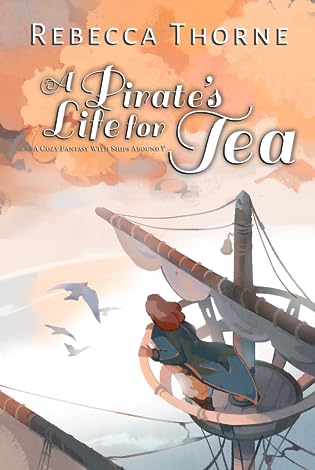 A Pirate's Life for Tea by Rebecca Thorne
A Pirate's Life for Tea by Rebecca Thorne Format: ebook
Source: purchased from Amazon
Formats available: paperback, ebook
Genres: cozy fantasy, fantasy
Series: Tomes and Tea #2
Pages: 454
Published by Rebecca Thorne on February 23, 2023
Purchasing Info: Author's Website, Amazon, Barnes & Noble, Kobo
Goodreads
While searching for stolen dragon eggs, newly engaged couple Kianthe and Reyna find themselves smack-dab in the middle of a swashbuckling love story.
On one side is Serina, a failed farmer turned river pirate. Her booty? Wheat, grains, and the occasional jar of imported tea leaves. It's quite the embarrassment to Diarn Arlon, the powerful lord of the Nacean River, and he'll conscript anyone to bring her to justice. Especially Kianthe, the elemental mage who just crashed his party, and her somewhat-scary fiancée.
Begrudgingly, the couple joins forces with Bobbie, one of Arlon's constables--who happens to be Serina's childhood friend. Bobbie is determined to capture the pirate before anyone else, but it would be a lot easier if Serina didn't absolutely loathe her now.
As Kianthe and Reyna watch this relation-shipwreck from afar, it quickly becomes apparent that these disaster lesbians need all the help they can get. Luckily, matchmaking is Reyna's favorite past time. The dragon eggs may have to wait.
My Review:
Just as with the first book in the Tomes & Tea series, Can’t Spell Treason without Tea, where I picked it up just because I discovered it existed while looking for information and readalikes for the lovely, wonderfully awesome Legends & Lattes, learned it was in the same cozy fantasy vein and was looking for more of THAT, please and with bells on, I picked up A Pirate’s Life for Tea because I was looking for more books with the same cozy fantasy vibe as Bookshops & Bonedust, the second book in the Legends series, and learned that the second Tomes & Tea book already existed.
Bookshops & Bonedust won’t be out until November, but A Pirate’s Life for Tea is out now and has been since June and I can’t believe I didn’t spot it when it first came out but I’m so damn glad it’s here now. Because it’s exactly what I was looking for and it’s even better than Can’t Spell Treason without Tea.
So YAY!
In many ways, A Pirate’s Life for Tea is the opposite of Treason. Treason was all about Reyna and Kianthe settling down together and figuring out how to make a life AND run a business together in the same place after years of clandestine meetings in out of the way places to keep Reyna’s psychopathic queen and Kianthe’s meddling bureaucrats from learning about their relationship and breaking it up – one way or another – before they decided what to be to each other.
At the point in their story where we get to catch up with them in A Pirate’s Life for Tea, they’ve been living in the quiet little border town of Tawney for over a year and happily running their combined bookshop and teahouse together. Life is good, but life is also a bit less adrenaline-inducing than former Queensguard Reyna is used to.
Which is when the excitement from the previous story rears its ugly head (literally as it turns out) and sends them to the domain of Diarn (read as Lord) Arlon in search of a shipment of stolen dragon eggs that seems to have passed through his lands – if not his actual hands – early in his rule.
The dragons want their eggs back and expect Kianthe and Reyna to find them – or their peaceful little town gets set on fire. Again. And Again.
But when Kianthe and Reyna get to Arlon, they find themselves caught up in the little pirate problem he seems to be having. They negotiate a trade, Kianthe and Reyna’s help with the pirate problem in return for Arlon’s shipping and taxing records from the time period they need to investigate.
And that’s where the fun comes in. Because Arlon is clearly not on the up and up. After all, it is only ONE pirate. Just one. That he can’t seem to catch even though it appears that half the population of his domain are on his payroll as constables. And because he’s just slippery and slimy in the way that all politicians are – if not a bit more.
However, Kianthe and Reyna involve themselves in the pirate problem mostly because Kianthe can’t resist meddling, either in the much bigger problem that the pirate represents – or in the romantic tangle that she senses between the constable assigned to bring in the pirate and the pirate she’s assigned to bring in.
Kianthe could be wrong – but not about this. She’s more than a bit wrong about how much even Reyna likes her truly execrable puns – but she’s not wrong about what’s not going on between the constable and the pirate. If only she can get them to see it for themselves.
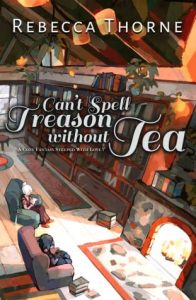 Escape Rating A-: A Pirate’s Life for Tea was even more cozy fantasy fun than Can’t Spell Treason without Tea with a bit less of the villain fail that plagued Treason. I fell straight into this heady brew of fantasy and froth and didn’t fall out until I closed the book with a grateful sigh for another lovely visit with Kianthe and Reyna.
Escape Rating A-: A Pirate’s Life for Tea was even more cozy fantasy fun than Can’t Spell Treason without Tea with a bit less of the villain fail that plagued Treason. I fell straight into this heady brew of fantasy and froth and didn’t fall out until I closed the book with a grateful sigh for another lovely visit with Kianthe and Reyna.
Made even that much more charming because we don’t often get to see what happens in a romance after the Happy Ever After, and this definitely does that while showing that there is still plenty of heat and romance after it seems like at least most of the dust has settled.
The thing about A Pirate’s Life for Tea and the whole Tomes & Tea series so far is that it’s a bit closer to its epic fantasy roots while still rocking that cozy fantasy vibe that everyone loved in Legends & Lattes.
So along with the surprisingly cozy pirate life and the strongly hinted at steamy pirate-themed romantic fantasies there’s also an epic political fantasy story being told about kingdom-equivalents becoming oppressive and king-wannabes turning tyrant and dirty deeds done dirt cheap being investigated by righteous outside forces in the forms of Mage of Ages Kianthe and her sword-wielding fiancee Reyna.
It’s just that in this cozy fantasy, evildoers don’t end up with their heads on pikes but do get their comeuppances. Results seldom result in death but rather in justice, and it makes for a glorious and dare I say comforting read that still has all the fantasy thrills that fantasy readers crave.
(If you’re wondering how this missed being a full A grade, in spite of how much I loved it while I was reading it, Diarn Alorn fell flat as a villain. He didn’t go full-on bwahaha the way the Queen did in Treason, but he’s just lacking in motive and pretty much everything else. Possibly he’s overcompensating for something (an idea which fits in with many of Reyna’s puns and the pirate romantic fantasy themes) but we don’t get to know what.)
So if you’ve heard about the new cozy fantasy thing, if you’re on tenterhooks waiting for Bookshops & Bonedust, or if you just fell hard for Kianthe and Reyna and their world in Can’t Spell Treason without Tea, A Pirate’s Life for Tea is a joy and a delight, that holds the promise of more in its epilog and I’m so there for it. Soon would be lovely.
And if the title of this one is driving you bananas, as it did me, because it sounds familiar but not quite, “A Pirate’s Life for Me” has been the theme song of the Pirates of the Caribbean theme park ride at Disney since 1967, and has been part of the soundtrack of all the Pirates of the Caribbean movies. Savvy?

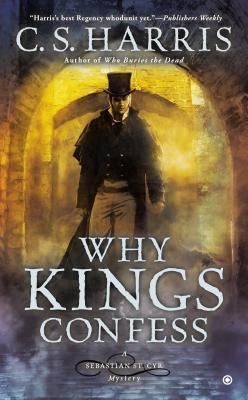 Why Kings Confess (Sebastian St. Cyr, #9) by
Why Kings Confess (Sebastian St. Cyr, #9) by 
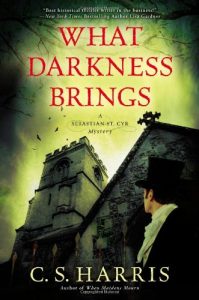 Escape Rating A-: This week already felt like a week and a half by the time I picked this book up on Wednesday – and there were still two days to go. I needed a comfort read, and it had been just long enough since I finished my previous
Escape Rating A-: This week already felt like a week and a half by the time I picked this book up on Wednesday – and there were still two days to go. I needed a comfort read, and it had been just long enough since I finished my previous 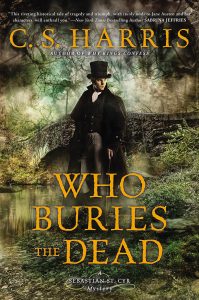 At the same time, the thing that makes the series different from other historical mysteries is its deep and penetrating dive into its historical setting. I know enough to get caught up in the political skullduggery behind the deaths to get sucked right in, and then find myself looking up details just to get that little bit more meat out of everything he’s just experienced and I’ve just read.
At the same time, the thing that makes the series different from other historical mysteries is its deep and penetrating dive into its historical setting. I know enough to get caught up in the political skullduggery behind the deaths to get sucked right in, and then find myself looking up details just to get that little bit more meat out of everything he’s just experienced and I’ve just read. Montego: A Glass Immortals Novella by
Montego: A Glass Immortals Novella by 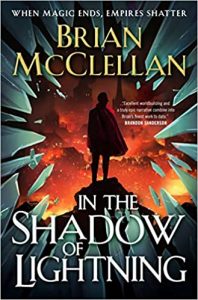 Escape Rating A: I had the oddest reaction at the end of Montego. I teared up. Not because this story ends on a sad note, because it doesn’t. It ends on a note of triumph and hope. But I wanted to cry because I know what those hopes lead to, and there’s a lot of heartbreak ahead for Demir, Montego and Kizzie. They just don’t know it yet.
Escape Rating A: I had the oddest reaction at the end of Montego. I teared up. Not because this story ends on a sad note, because it doesn’t. It ends on a note of triumph and hope. But I wanted to cry because I know what those hopes lead to, and there’s a lot of heartbreak ahead for Demir, Montego and Kizzie. They just don’t know it yet.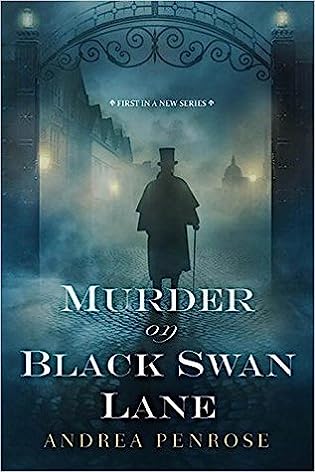 Murder on Black Swan Lane (Wrexford & Sloane, #1) by
Murder on Black Swan Lane (Wrexford & Sloane, #1) by 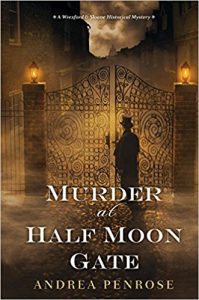 The Sherlockian overtones of Wrexford’s unemotional demeanor contrasted with Sloane’s carefully banked emotions as well as their opposition in gender and station gives this case much of its dramatic tension as well as providing plenty of opportunity for the characters to spark off each other so hard they very nearly set the scene afire. Not that there aren’t plenty of fires and even explosions of a slightly more mundane origin to deal with! They are clearly people who can’t be neutral about each other, even when they are on the same side. Where those sparks will lead them will undoubtedly be explored in the books to come, along with whatever else Sloane is hiding from both Wrexford and from herself.
The Sherlockian overtones of Wrexford’s unemotional demeanor contrasted with Sloane’s carefully banked emotions as well as their opposition in gender and station gives this case much of its dramatic tension as well as providing plenty of opportunity for the characters to spark off each other so hard they very nearly set the scene afire. Not that there aren’t plenty of fires and even explosions of a slightly more mundane origin to deal with! They are clearly people who can’t be neutral about each other, even when they are on the same side. Where those sparks will lead them will undoubtedly be explored in the books to come, along with whatever else Sloane is hiding from both Wrexford and from herself.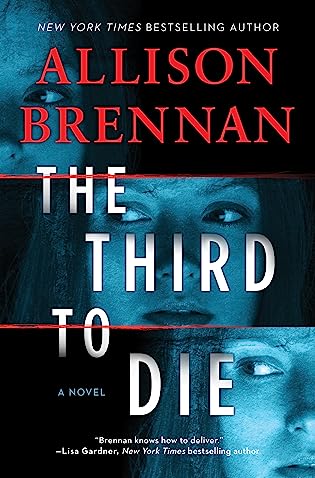 The Third to Die (Quinn & Costa #1) by
The Third to Die (Quinn & Costa #1) by  I fell hard for this compelling mystery/suspense/thriller series a couple of years ago when I got utterly absorbed in the second book in the series,
I fell hard for this compelling mystery/suspense/thriller series a couple of years ago when I got utterly absorbed in the second book in the series,  Costa needs all the help he can get. Kara needs a case to keep her mind occupied while she waits to discover what is happening with the case back in LA. And the killer is compelled to complete his self-appointed mission at all costs.
Costa needs all the help he can get. Kara needs a case to keep her mind occupied while she waits to discover what is happening with the case back in LA. And the killer is compelled to complete his self-appointed mission at all costs.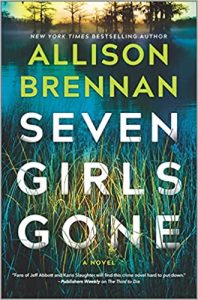 What keeps The Third to Die moving at its breakneck pace – in spite of its length – is the ticking clock the team is driven by every single minute. The Triple Killer kills on March 3, March 6, and March 9. Kara Quinn discovers the body on the morning of March 3. The team has to get from Washington DC to Washington state and hit the ground running, with less than 72 hours until the next body drops. They have no leads, no motives, no suspects. And not just one but two local jurisdictions who are less than thrilled with the FBI operating on their turf without so much as a ‘by your leave’.
What keeps The Third to Die moving at its breakneck pace – in spite of its length – is the ticking clock the team is driven by every single minute. The Triple Killer kills on March 3, March 6, and March 9. Kara Quinn discovers the body on the morning of March 3. The team has to get from Washington DC to Washington state and hit the ground running, with less than 72 hours until the next body drops. They have no leads, no motives, no suspects. And not just one but two local jurisdictions who are less than thrilled with the FBI operating on their turf without so much as a ‘by your leave’. Chef's Choice (Chef's Kiss, #2) by
Chef's Choice (Chef's Kiss, #2) by  Our story begins a few months after the end of the companion story,
Our story begins a few months after the end of the companion story, 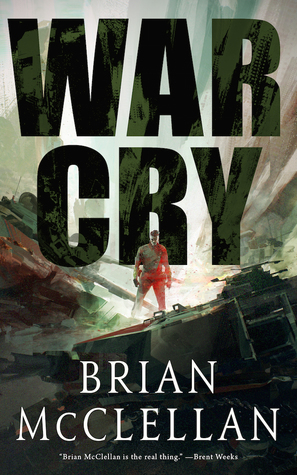 War Cry by
War Cry by 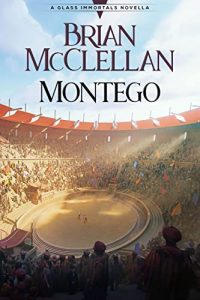 This turns out to be a story that embodies, not just Sherman’s “War is Hell” quote, but more especially a less often seen quote from G.K. Chesterton that goes, “The true soldier fights not because he hates what is in front of him, but because he loves what is behind him.” Or in the case of Teado and his company, because he loves what is beside him.
This turns out to be a story that embodies, not just Sherman’s “War is Hell” quote, but more especially a less often seen quote from G.K. Chesterton that goes, “The true soldier fights not because he hates what is in front of him, but because he loves what is behind him.” Or in the case of Teado and his company, because he loves what is beside him.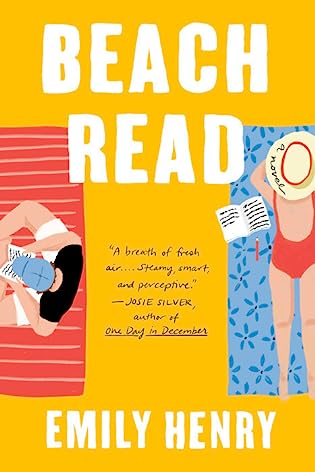 Beach Read by
Beach Read by  Beach Read has been in the virtually towering TBR pile ever since I read – and fell in love with –
Beach Read has been in the virtually towering TBR pile ever since I read – and fell in love with –  While it was a given from the outset that January and Gus were going to reach at least the kind of happy for now that both the character January AND the author usually write, what made this book interesting and different was the books that January and Gus each produced on their way to it, and how those books managed to be both a departure from their usual styles while still expressing the core parts of their personalities and their reasons for becoming writers in the first place.
While it was a given from the outset that January and Gus were going to reach at least the kind of happy for now that both the character January AND the author usually write, what made this book interesting and different was the books that January and Gus each produced on their way to it, and how those books managed to be both a departure from their usual styles while still expressing the core parts of their personalities and their reasons for becoming writers in the first place. Rose/House by
Rose/House by 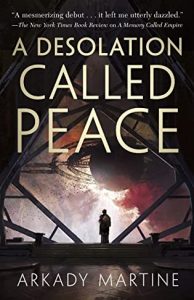 Escape Rating B-: I picked this up because I still miss Teixcalaan. (Yes, I know I said that the ending of
Escape Rating B-: I picked this up because I still miss Teixcalaan. (Yes, I know I said that the ending of 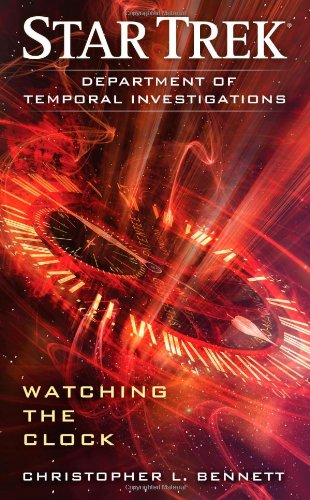 Watching the Clock (Star Trek: Department of Temporal Investigations #1) by
Watching the Clock (Star Trek: Department of Temporal Investigations #1) by  Which sounds a lot like what the Borg were attempting in
Which sounds a lot like what the Borg were attempting in